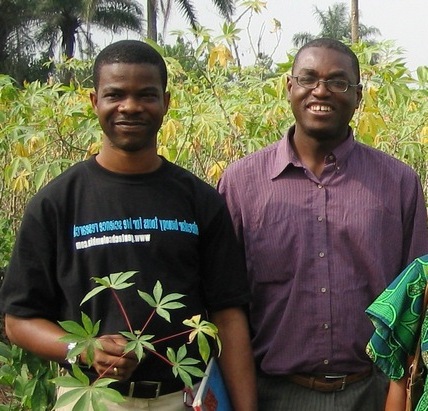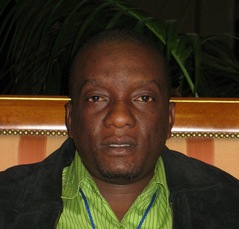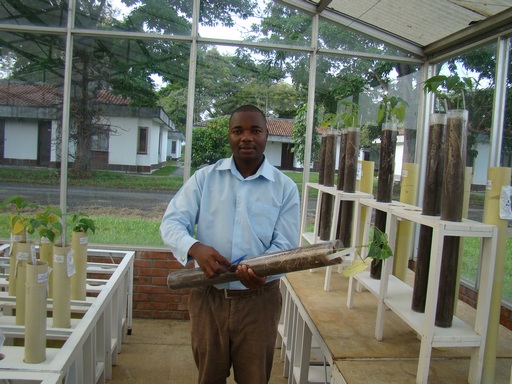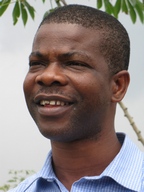
Chiedozie Egesi
Despite the social injustice around me, I always thought there was opportunity to improve people’s lives…GCP helped us to build an image for ourselves in Nigeria and in Africa, and this created a confidence in other global actors, who, on seeing our ability to deliver results, are choosing to invest in us.”
– Chiedozie Egesi, a would-have-been surgeon who switched sides to biology and crop genetics, and who got acquainted with GCP through the Internet.
Backdrop: A booming economy and a wealth of natural resources may be among some of the common preconceptions of the average Jane and Joe regarding Africa’s most populous nation. Lamentably, however, Nigeria, like numerous robust economies worldwide, is still finding its feet in addressing severe inequality and ensuring that the nation’s wealth also flows to the poorest and most marginalised communities.
It’s a problem Chiedozie Egesi (pictured above), a molecular plant breeder at Nigeria’s National Root Crops Research Institute (NRCRI), understands well: “Nigeria is an oil-producing country, but you still see grinding poverty in some cases. Coming from a small town in the Southeast of the country, I grew up in an environment where you see people who are struggling, weak from disease, poor, and with no opportunities to send their children to school,” he reveals. The poverty challenge, he explains, hits smallholder farmers particularly hard: “Urban ‘development’ caught up with them in the end: some of them don’t even have access to the land that they inherited, so they’re forced to farm along the street.”
Food first! A man with a mission and fire in his belly, determined to make a difference
For this gifted and socially conscious young man, however, the seemingly bleak picture only served to ignite a fierce determination and motivation to act: “Despite the social injustice around me, I always thought there was opportunity to improve people’s lives.” And thus, galvanised by the plight of the Nigerian smallholder, plans for a career in medical surgery were promptly shelved, and traded for biological sciences and a PhD in crop genetics, a course he interspersed with training stints at USA’s Cornell University and the University of Washington, Seattle, along the way, before returning to the motherland to accept a job as head of the cassava breeding team, and – following a promotion in 2010 – Assistant Director of the Biotechnology Department, at NRCRI.
As evident from the burgeoning treasure chest of research gems to his name, it was a professional detour which paid off, and which continues to bear fruit today.
Making a marked difference, cultivating new partnerships, and looking beyond subsistence
In 2010, work by Chiedozie and his NRCRI team resulted in the official release of Africa’s first molecular-bred cassava variety which was both disease-resistant and highly nutritious – an act they followed in 2012 with the release of a high-starch molecular-bred variety. The team’s astute navigation of molecular markers resulted in breeding Latin American cassava varieties resistant to cassava mosaic disease (CMD), leading to the release of CMD-resistant cassava varieties in the African continent for the first time. Genetic maps intended to enhance breeding accuracy for cassava – the first of their kind for the crop in Africa – have been produced, and quantitative trait loci (QTLs) for cassava breeding are in the making. In 2011, the team, together with their partners at the International Institute of Tropical Agriculture (IITA) and HarvestPlus (a CGIAR Challenge Programme), released three pro-vitamin A-rich varieties of cassava, which hold the potential to provide children under five and women of reproductive age with up to 25 percent of their daily vitamin A allowance – a figure Chiedozie and his team are now ambitiously striving to increase to 50 percent.
These new and improved varieties – all generated as a direct or indirect result of his engagement in GCP projects – are, Chiedozie says, worth their weight in gold: “Through these materials, people’s livelihoods can be improved. The food people grow should be nutritious, resistant and high-yielding enough to allow them sell some of it and make money for other things in life, such as building a house, getting a motorbike, or sending their kids to school.”
Prior to my GCP work, I was more or less a plant breeder, and a conventional one at that. Whilst I’d been exposed to molecular tools during my early work on yam and other crops, I was not applying them in my work back then…GCP was not only there to provide technology but also to guide you in how to operate that technology… Now all our staff understand what is meant by good breeding, data analysis or applying genotypic data. My whole team benefitted.”
A chance ‘meeting’, with momentous manifold connections
Having first stumbled across the GCP website by chance when casually surfing the internet one day in a cyber café back in 2004, Chiedozie’s attention was caught by an announcement for a plant breeders’ training course in South Africa, an opportunity which he applied for on the off chance…and for which, hey presto!, he was accepted! Thus, his GCP ‘adventure’ began!
Promptly revealing an exceptional craftsmanship for all things cassava, Chiedozie soon became engaged in subsequent opportunities, including a one-year GCP fellowship at the International Centre for Tropical Agriculture (CIAT) in Colombia, a number of GCP Capacity building à la carte-facilitated projects, and, more recently, a major role as a Principal Investigator in the GCP Cassava Research Initiative (RI), teaming up with NRCRI colleague and Cassava RI Product Delivery Coordinator, Emmanuel Okogbenin. The Cassava RI is where Chiedozie’s energies are primarily invested at present, with improving and deploying markers for biotic stresses in cassava being the name of the game.
The significance of his GCP engagements was, Chiedozie affirms, momentous: “Prior to my GCP work, I was more or less a plant breeder, and a conventional one at that. Whilst I’d been exposed to molecular tools during my early work on yam and other crops, I was not applying them in my work back then.”
Collaboration in a GCP-funded project with CIAT led to the development of a new laboratory space for NRCRI, bolstered by support for basic materials as well as training. “GCP was not only there to provide technology but also to guide you in how to operate that technology,” Chiedozie comments. (For more on how it all began, see At home and to go and Molecular bonds in pp 26–29 in this e-book)
GCP’s Integrated Breeding Platform (IBP), he says, has played a vital role in this regard: “By opening the door to training, generation of data, analysis of data, and by giving support in making decisions, GCP’s IBP serves as a one-stop shop for cassava breeding.” It’s a sentiment shared by his NRCRI colleagues, he says: “GCP is providing a comprehensive full-package deal. Besides myself, several colleagues have been trained at NRCRI. Now all our staff understand what is meant by good breeding, data analysis or applying genotypic data. My whole team benefitted.”
A real deal-breaker is the facilitation of self-empowerment amongst national programmes, and the new avenues unfolding for enhanced collaboration at the local, national and regional level…What we’re seeing is a paradigm shift. In the past there was a general belief that this kind of advanced molecular science was only feasible in the hands of CGIAR Centres or developed-country research institutes – the developing-country programmes were never taken seriously. When the GCP opportunity to change this came up we seized it, and now the developing-country programmes have the boldness and capacity to do molecular breeding and accurate phenotyping for themselves.”
Growth in numbers, capital, capacity, collaboration, reach and impact
Strength in numbers, Chiedozie says, is a vital lifeline for cassava, a crop which has suffered years of financial neglect. As such, a real deal-breaker in Chiedozie’s eyes is the facilitation of self-empowerment amongst national programmes, and the new avenues unfolding, thanks to his involvement in the GCP cassava breeding Community of Practice (CoP), for enhanced collaboration at the local, national and regional level: “We now have a network of cassava breeders that you can count on and relate with in different countries. This has really widened our horizons and also made work more visible,” he offers, citing effective links formed with Ghana, Sierra Leone, Liberia, Mozambique, Malawi and Côte d’Ivoire, amongst several other cassava-breeding neighbours near and far.
The achievements amongst this mushrooming community are, he stresses, unprecedented: “Participation in the CoP means many countries can now create their own hybrids and carry out their own selection, which they could not do before,” he affirms.
And it’s a milestone Chiedozie and colleagues are justifiably proud of: “What we’re seeing is a paradigm shift. In the past there was a general belief that this kind of advanced molecular science was only feasible in the hands of CGIAR Centres or developed-country research institutes – the developing-country programmes were never taken seriously. When the GCP opportunity to change this came up we seized it, and now the developing-country programmes have the boldness and capacity to do molecular breeding and accurate phenotyping for themselves,” Chiedozie confirms.
GCP helped us to build an image for ourselves in Nigeria and in Africa, and this created a confidence in other global actors, who, on seeing our ability to deliver results, are choosing to invest in us.”
Building on success, going from strength to strength as the sands shift
With internal capacity now blossoming of its own accord – in no small measure due to the leading role played by NRCRI in the sensitisation of cassava plant breeders throughout Nigeria and beyond – the sands are certainly shifting: “GCP helped us to build an image for ourselves in Nigeria and in Africa, and this created a confidence in other global actors, who, on seeing our ability to deliver results, are choosing to invest in us.”
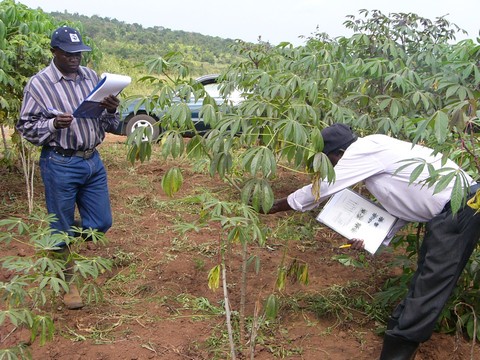
Visitors with working clothes on: NaCRRI Uganda’s Anthony Pariyo (left) and Williams Esuma (right) visiting NRCRI Umudike on a breeder-to-breeder visit in July 2012. Williams’ postgraduate studies were funded by GCP through the cassava CoP.
And the beauty of it, Chiedozie continues, is that the cassava crew is going from strength to strength: “Nigeria is seen as a really strong cassava-breeding team, not only within Africa but also globally. And we have not yet realised all the benefits and potential – these are still unfolding,” he enthuses.
Also yet to unfold are Chiedozie’s upcoming professional plans, which, he reveals, will soon see him engaging with the USA’s Cornell University, the Bill & Melinda Gates Foundation, the International Institute of Tropical Agriculture (IITA) and Uganda’s National Crop Resources Research Institute (NaCRRI) in an initiative which, through its focus on genomic selection in cassava breeding, promises to be, Chiedozie reveals, “at the frontier of cutting-edge technology.” Genomic selection for this initiative is already underway.
Readers intrigued by this tantalising taster of what to expect in Chiedozie’s next professional chapter are encouraged to watch this space over the coming years…Judging by his remarkable research record to date, we feel confident that future installments will not disappoint!
Meantime, here’s Chiedozie’s presentation at the GCP General Research Meeting in September 2013. We are also working on videos of Chiedozie and his work. Yet more reason to watch this space!
- For a picture of Chiedozie’s work near the beginning in 2006, see pp 26–29 here (At home and to go and Molecular bonds)
- More recent updates are on the Cassava InfoCentre








